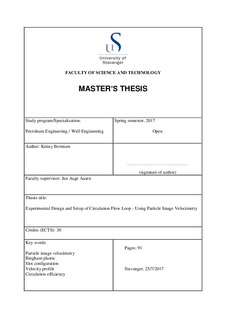| dc.contributor.author | Berntsen, Kenny | |
| dc.date.accessioned | 2017-10-26T08:34:29Z | |
| dc.date.available | 2017-10-26T08:34:29Z | |
| dc.date.issued | 2017-07-25 | |
| dc.identifier.uri | http://hdl.handle.net/11250/2462280 | |
| dc.description | Master's thesis in Petroleum engineering | nb_NO |
| dc.description.abstract | Mud left static in a well over a longer period of time can begin to gel up or form filter cakes along the formation wall and in washout zones, which can be difficult to remove. Therefore, proper mud mobilization and removal is necessary to ensure a good zonal isolation prior to primary cementing.
The Bingham plastic rheology model is widely used by mud engineers to mathematically describe the rheological behavior of drilling fluids. The equation for circulation efficiency is directly related to the fluid velocity profile equations.
Relevant theory is introduced before experimentation and results are presented. The experimental work in this thesis is based on a field size mud conditioning operation. The annular geometry between a 95/8-in casing and a 121/4-in borehole is scaled down to laboratory size and configured as a slot for experimental purposes. Accompanying mud rheology and conditioning pump rate is scaled down by the Bingham number similarity method.
Particle image velocimetry (PIV) experiments were conducted on an acrylic flow channel for a Newtonian fluid to study the velocity profile. An aspect ratio of 1:10 was found to be acceptable to neglect the sidewall effects when measuring the velocity profile 8,5 centimeters from the wall, both from theoretical solutions and by comparing with experimental results.
Carbopol dispersed in an aqueous solution was found to be the most promising yield stress fluid for the future non-Newtonian PIV experiments. Despite being described better by the Herschel-Bulkley rheology model rather than the Bingham plastic model, its rheology was found to be acceptable by comparing the velocity profiles generated by the regression parameters by the two rheology models
Both analytical solutions and MATLAB were used to verify the aspect ratio and feasibility of moving on with Carbopol. | nb_NO |
| dc.language.iso | eng | nb_NO |
| dc.publisher | University of Stavanger, Norway | nb_NO |
| dc.subject | petroleumsteknologi | nb_NO |
| dc.subject | petroleum engineering | nb_NO |
| dc.subject | well engineering | nb_NO |
| dc.title | Experimental Design and Setup of Circulation Flow Loop - Using Particle Image Velocimetry | nb_NO |
| dc.type | Master thesis | nb_NO |
| dc.description.version | submittedVersion | nb_NO |
| dc.subject.nsi | VDP::Teknologi: 500::Berg‑ og petroleumsfag: 510::Petroleumsteknologi: 512 | nb_NO |
